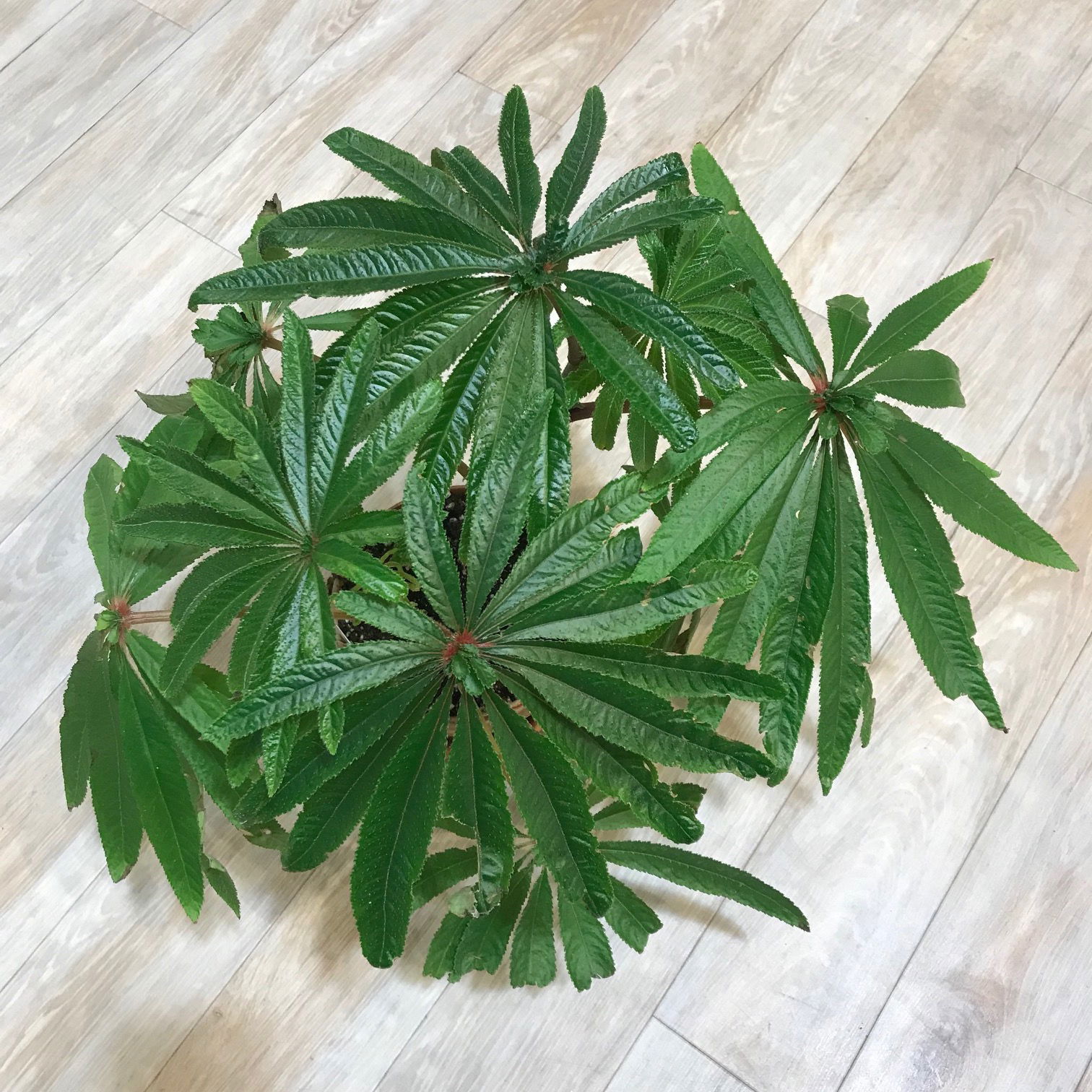
Begonia luxurians
Contents
- Top Tips
- Location, Water, Humidity & Fertilisation
- Common Issues
- Origins, Temperature, Propagation, Repotting & Toxicity.
Need the answer to a specific plant query? Book a 1-to-1 video call with THE HOUSEPLANT DOCTOR™, the website's friendly author, to overcome and address your niggling problem! Available on iMessage, WhatsApp, Facebook Messenger & more.
Top Tips & Info
- Care Difficulty - Easy
- Provide a bright location with minimal sunlight throughout the year.
- Keep the soil evenly moist, allowing the top third to dry out in between hydrations. Avoid promoting droughts due to the heightened chance of yellowed or browned leaves and weak growth.
- Fertilise using a 'Houseplant' labelled feed every four waters in the spring and summer, reducing this to every six in the colder months.
- Pink flowers will readily flourish from the summer onwards that can last up to six weeks. Swap the 'Houseplant' feed for a product high in potassium during this time to help prolong the blooms. 'Tomato' food is an excellent example.
- In spring, repot every three years with 'Houseplant' labelled compost. Water the plant 24hrs beforehand, to reduce the risk of damaging the root hairs. (Transplant Shock).
Location & Light - 🔸🔸
Provide a bright environment with an hour or two of off-peak sunlight throughout the year. Locations that are too dark will cause an increased chance of mould developing on the soil and root rot due to the slowed rates of photosynthesis (& water-uptake in the roots). The ideal setting for this plant is within two metres of north, east or west-facing window, or in a semi-shaded conservatory.
Water - 🔸🔸🔸
Although this Begonia can withstand short-lived droughts, it's best to hydrate the soil once the top third dries out, reducing this slightly further in the autumn and winter. During irrigation, use tepid water to prevent hurting their sensitive roots from the sudden temperature change - if it's too cold for your teeth, it'll be the same for the plant, too! Under-watering symptoms include stunted growth, crispy brown patches forming on the leaves, yellow older leaves and wilting. Due to the Begonia's need for regular moisture, dehydration is a common problem that can be sped up by too much light or heat. Over-watering symptoms include mouldy soil, yellowing lower leaves, leaf blotches in brown, yellow or black, wilting and rotted stems/roots. Although it's under-watering that you'll need to manage, locations that are too dark may also cause soil-bourne diseases such as root rot if it's kept too moist. Click here to learn more about identifying and addressing root rot.
Humidity - 🔸🔸
Average room humidity is more than enough to satisfy this plant. Never situate it within a few metres of an operating radiator due to the enriched chance of browning leaf-tips.
For those who tend to under-water, create a humidity tray to provide a moist environment and prolong the rate of drying-soil. Hose the foliage down from time to time to hydrate the leaves and keep the dust levels down.
Fertilisation - 🔸🔸
Fertilise every four waters during the growing period before reducing this to every six in the autumn & winter. Although an 'All-Purpose' fertiliser will still do the job, we'd recommend using a specific 'Houseplant' labelled fertiliser as it'll support the vital thirteen nutrients that this species will need to grow.
While the specimen is budding or in bloom, switch to a product high in potassium to prolong the duration of flowers. Good examples of this are a 'Poinsettia' or 'Tomato' labelled feed. Revert to the original fertiliser once the final inflorescence elapses.
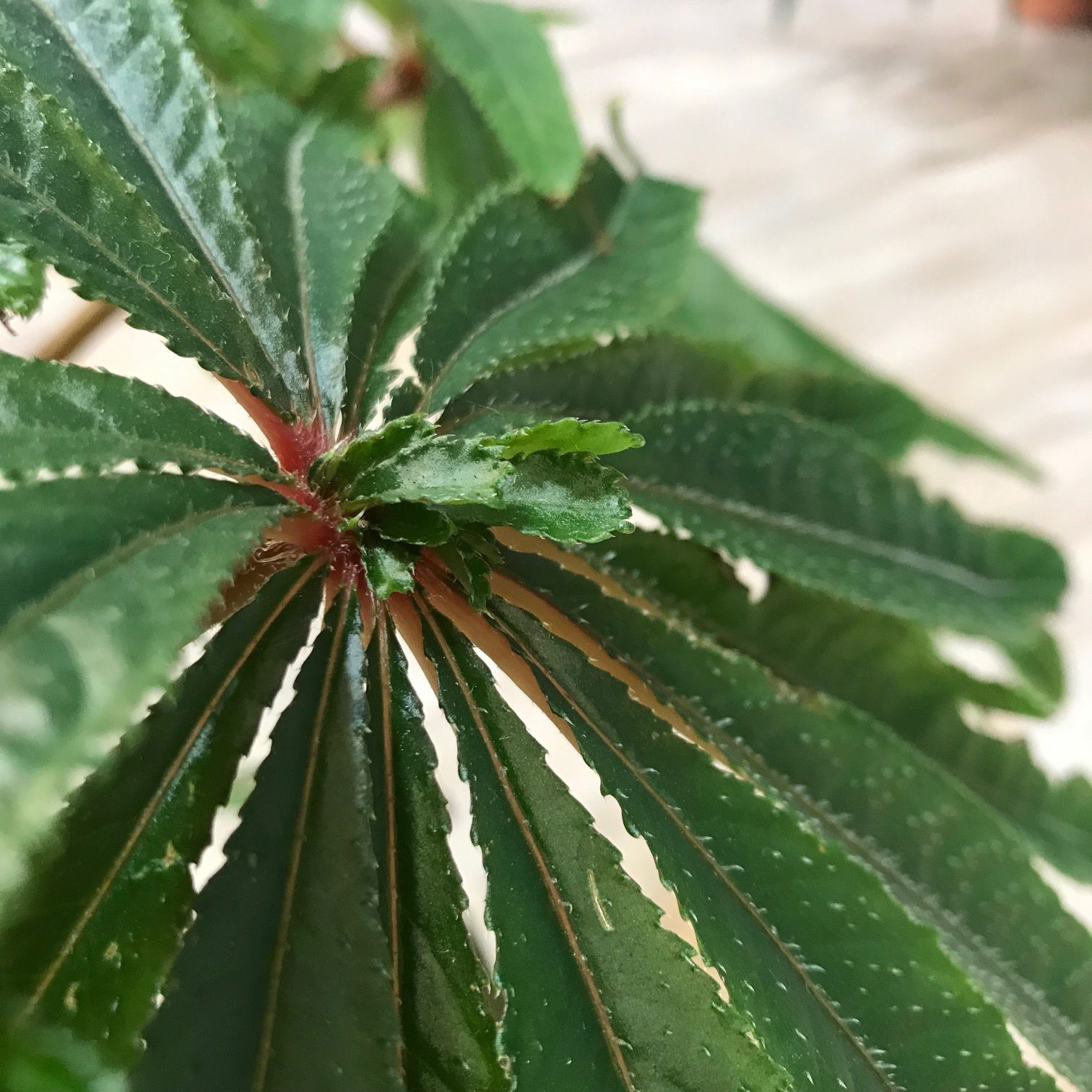 In some cases, due to their erratic growth rates, a secondary cluster of foliage may grow within the centre of the original leaf.
In some cases, due to their erratic growth rates, a secondary cluster of foliage may grow within the centre of the original leaf.
Common Issues with Begonia Luxurians
Older leaves that rapidly become yellow are a clear sign of over-watering, usually caused by too little light, with other symptoms include mouldy or heavy soil, stunted growth and a rotten base. Although Begonia can do well in darker locations, the frequency of irrigations must be reduced to counteract the chance of root rot. People don't realise that a plant's root system needs access to oxygen too; when soil is watered, the air will travel upwards and out of the potting mix. A lack of accessible oxygen will cause them to subsequently breakdown over the oncoming days. Click on this link to learn more about root rot and how to address it.
Over time, your Begonia will become leggy after a while, which is normal behaviour for an establishing specimen. You can prune the specimen back by a third (to promote a more bushy appearance) and use the prunings as stem cuttings. Place their bottom halves in water for around eight weeks to root. Once the roots are over 3cm (1.2 inches), place them into the mother plant's pot to increase the number of leaves closer to the soil. Scroll down to 'Propagation' to learn more about this!
Persistent droughts will result in crispy brown sections across its foliage. Allow the affected leaf to thoroughly brown over before removing it with a clean pair of scissors, as puncturing the soft tissue may cause bacterial diseases further down the line. Introduce a watering schedule or pebble tray to avoid the risk of dehydration in the future.
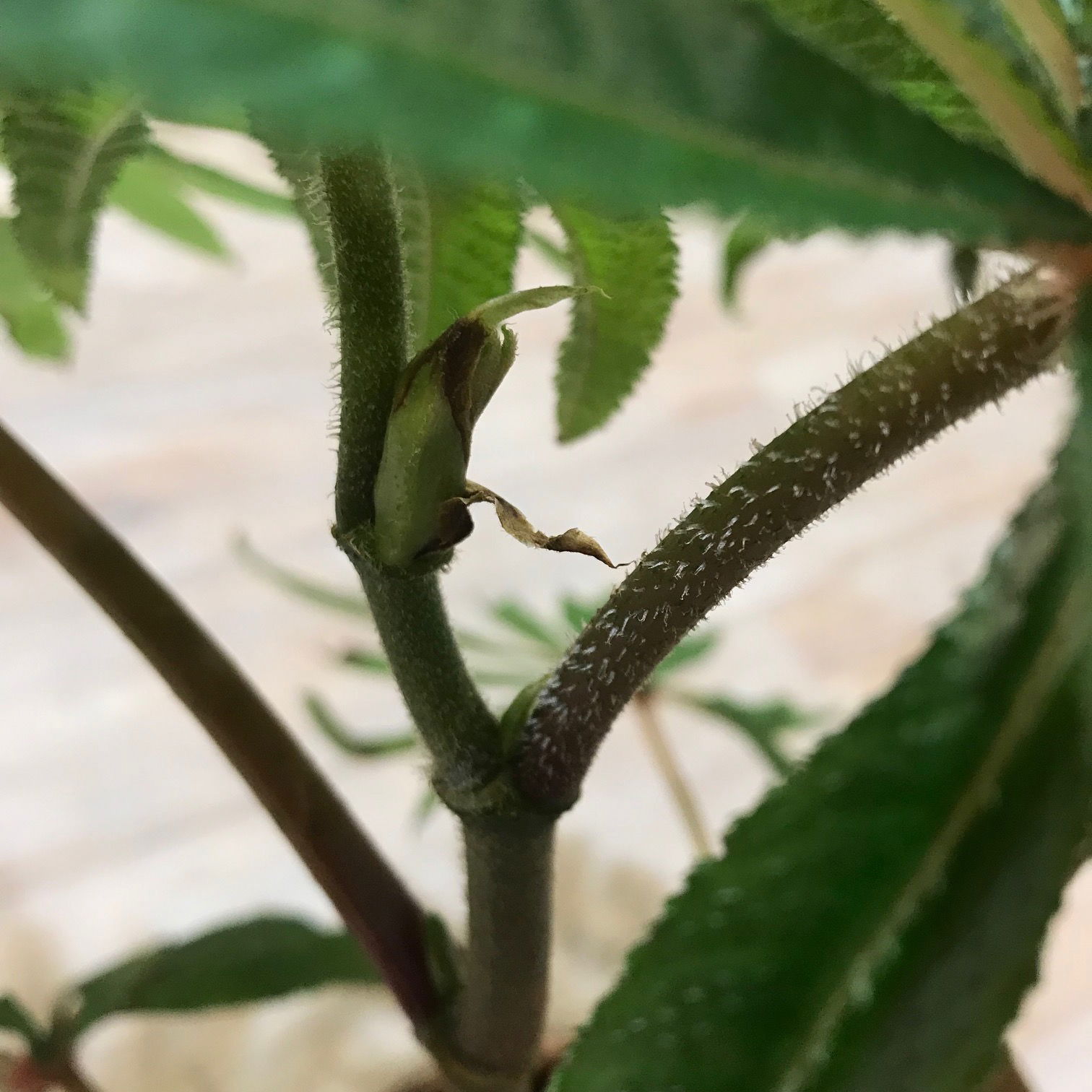 The sheath (pictured above) will brown and crisp over once the juvenile leaf reaches a certain maturity. This protective 'leaf' can be removed when it becomes fully brown and crispy.
The sheath (pictured above) will brown and crisp over once the juvenile leaf reaches a certain maturity. This protective 'leaf' can be removed when it becomes fully brown and crispy.
Severe dry air may cause browning leaf tips with yellow halos. Although this won't kill the plant, increase humidity to prevent new growth in adopting these symptoms. Either mist weekly while the heaters are on, or create a humidity tray to present a better growing condition.
Clean the leaves regularly. Although this isn't too much of an issue, a build-up of dust particles can clog up the plant's pores, causing lowered light capturing-efficiency. Rinse the topsides of the leaves down once a month to keep levels down and improve growing conditions.
Spider Mites are small, near-transparent critters, that'll slowly extract the chlorophyll from of its leaves. Have a check under the foliage, most notably along the midrib, for small webs and gritty yellow bumps. Click here to read our article about the eradicating Spider Mites, along with some extra tips that you may not find elsewhere!
The browning of the sheath's casing shouldn't of be a concern, as it's a wholly natural process which affects all specimens across the world. Remove the brown section once it becomes dry and crispy, using your hands to peel back the browned tissue and improve its overall appearance.
A lack of flowers is caused by an insufficient dormancy period, where the temperatures are kept more or less the same over the year. Reduce the warmth by a couple of degrees over the autumn and winter months, along with fewer irrigations to ensure a well-spent dormancy. Supplement in the weeks leading up to potential buds (early summer) with a potassium-based fertiliser, for instance, tomato food.
Origins
The name, Begonia, was penned by Charles Plumier who was a French botanist in the seventeenth century. Carl Linnaeus adopted this name in 1753, honouring a well-respected governor of Haiti, named Michel Bégon. The genus has almost two thousand accepted species that have natural distributions across five continents, except Europe and Antarctica.
The species, B. luxurians, was first described by Michael Scheidweiler in 1848, using the Latin word for 'luxuriant' in reference to the appealing foliage. It has natural distributions across central-east South America.
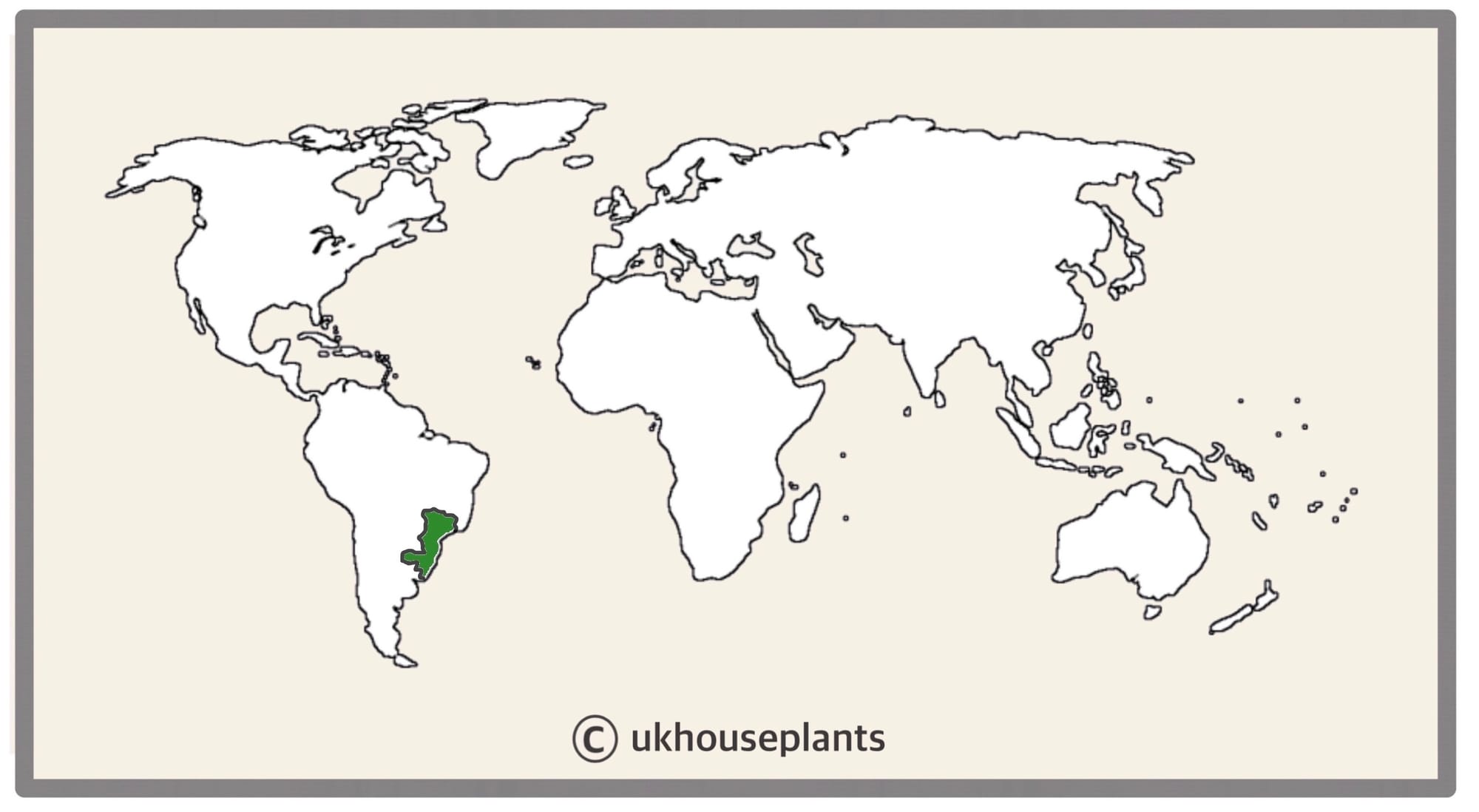 The Distribution of Begonia luxurians
The Distribution of Begonia luxurians
Temperature
5° - 30°C (40° - 86°F)
H2 (Hardiness Zone 10) - Tolerant of temperatures above freezing. This plant will die if left in temperatures below frosts; move to a conservatory or greenhouse until this risk has elapsed.
Begonia luxurians is best cultivated in temperatures between 12° - 25°C (54° - 77°F) as sudden or inconsistent fluctuations may result in lower leaf loss and stunted growth.
Spread
Up to 3m in height and 70cm in width, when maturity is reached in around six years. Similar to most cane-stemmed Begonia, B. luxurians is considered a rapid-growing species that can grow up to 25cm per season.
Pruning & Maintenance
Remove yellow or dying leaves, and plant debris to encourage better-growing conditions. While pruning, always use clean utensils or shears to reduce the chance of bacterial and fungal diseases. Never cut through yellowed tissue as this may cause further damage in the likes of diseases or bacterial infections. Remember to make clean incisions as too-damaged wounds may shock the plant, causing weakened growth and a decline in health.
Remove browned sheathes once they become dry and crispy, using your hands to peel it back for the improved appearance.
Propagation
Via Seed or Stem Cuttings.
Stem Cuttings via Water - (Easy)
- Choose the healthiest stems that are located in the top half of the foliage. This propagation method can be taken from spring to summer, with the stem being at least 10cm in length with two nodes (one for foliar development and the other for root growth). Although more nodes are acceptable, be sure only to submerge the bottom one to avoid inappropriate rooting elsewhere, which will be difficult to pot-up when it's time for soil placement. Be sure to use stems that HAVEN'T bloomed as energy-loss through the development of flowers will result in unsuccessful rooting.
- Cut 3cm below a node using a clean knife to reduce bacteria count. Remove the lower leaf and place the stems into a container of lukewarm water. Be sure to only submerge the bottom node into the water, with its foliage staying above the water line to prevent disease.
- Replace the water weekly, using lukewarm water to avert shocking the cutting with cold temperatures.
- Once the roots surpass 3cm ( 3.7 inches) in length, it's time to pot the specimen. Choose a potting mix - 'Houseplant' compost is best, but a multi-purpose compost with a splash of grit or perlite is acceptable, too.
- Use a 7cm (1 inch) pot that has suitable drainage holes - plastic or terracotta are both acceptable in this instance. Try not to over-pot the cuttings; blackleg occurs when the bottom wound becomes infected, typically caused by water-logging or a too-damaged wound.
- Fill the bottom third with soil and rest the plant on top. Pour the rest of the compost around the roots until it fills the top three-quarters of the pot. Gently tap the sides to remove any air pockets and to even out the soil structure. Never compact the compost for stability as it'll cause root rot by forcing the oxygen to the surface when irrigated. If it needs to be supported, use a cane!
- Avoid direct sunlight and offer good humidity by introducing a pebble tray to avert dehydration. Keep the soil evenly moist, allowing only the top inch to dry out in between waters. After a month of solid foliar growth, treat like an established specimen by following the care tips above!
Flowers
Flowers will be developed on specimens over three years old between the months of May to September. Although minimal work needs to be done for enticing a bloom, you can increase this chance by placing your Begonia luxurians in a cooler windowsill over the period of autumn to early spring to force it into a dormancy. Once the natural temperatures of the windowsill increase during mid spring, it'll know that summer is on its way and will want to prepare itself for reproduction (via the flowers) in the summer.
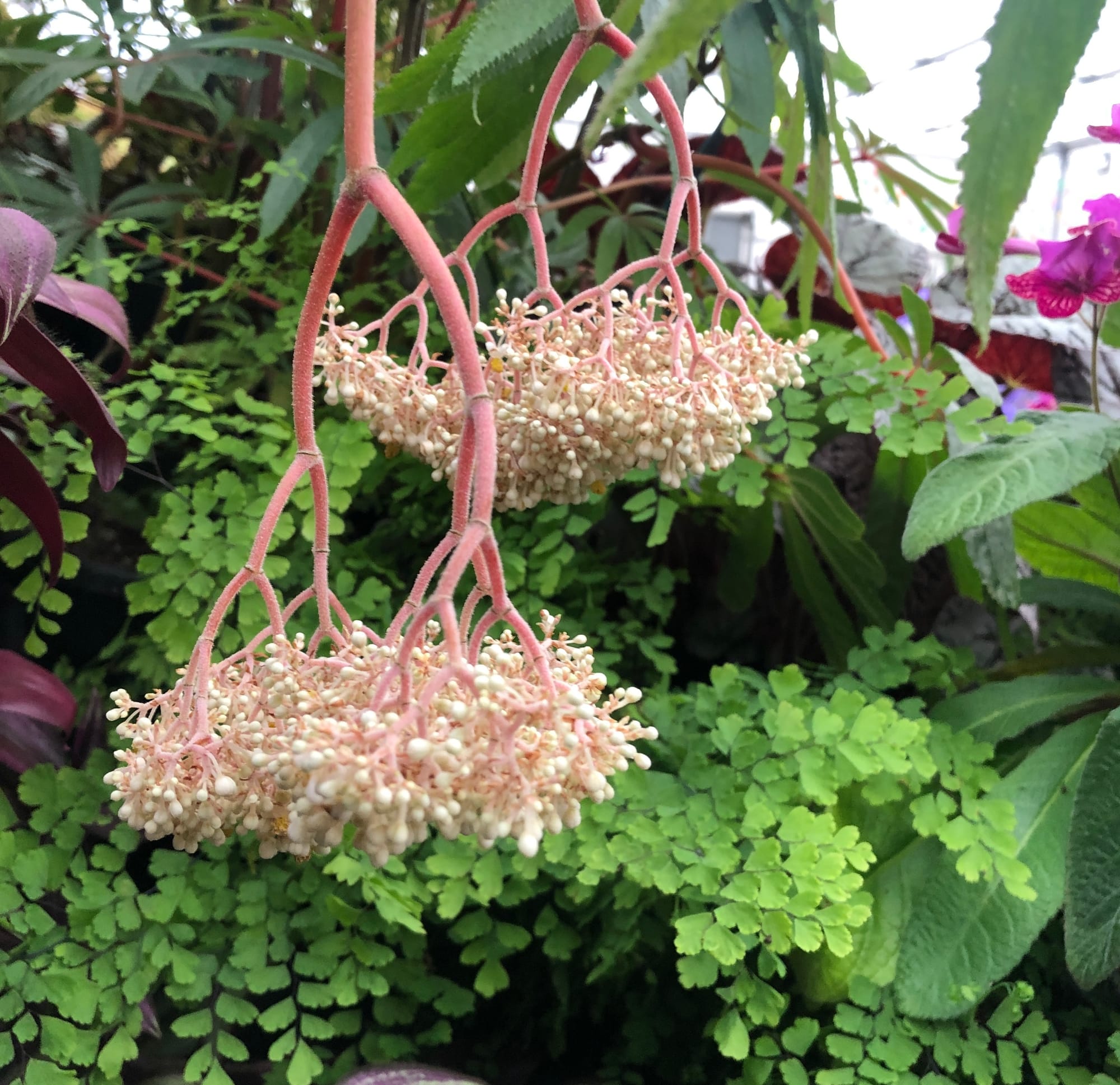 Each individual flower will bloom for around two weeks, with the overall show lasting around six weeks.
Each individual flower will bloom for around two weeks, with the overall show lasting around six weeks.
Repotting
Repot every three years in the spring, using a 'Houseplant' labelled compost and the next sized pot with adequate drainage. Hydrate the plant 24hrs before tinkering with the roots to prevent the risk of transplant shock. For those that are situated in a darker location, add a thin layer of small grit in the pot's base to improve drainage and downplay over-watering. Click here for a detailed step-by-step guide on transplantation, or via this link to learn about repotting with root rot.
Book a 1-to-1 video call with THE HOUSEPLANT DOCTOR™ if you'd like a personal guide to repotting your houseplant. This will include recommending the right branded-compost and pot size, followed by a live video call whilst you transplant the specimen for step-by-step guidance and answer any further questions!
Pests & Diseases
Keep an eye out for mealybugs, aphids, spider mites, scale, thrips, blackfly & vine weevils that'll locate themselves in the cubbyholes and undersides of the leaves, with the exception of the latter in soil. Common diseases associated with Begonia are root rot, anthracnose, cercospora, leaf-spot disease, botrytis (grey mould), rust, powdery mildew & southern blight - click here to learn more about these issues.
Toxicity
This plant is classified as poisonous, so if small sections are eaten, vomiting, nausea and a loss of appetite may occur. Consumption of large quantities must be dealt with quickly; acquire medical assistance for further information.
Retail Locations
Online Stores.
Book a 1-to-1 Call with THE HOUSEPLANT DOCTOR™
If you need further advice with your houseplants, book an advice call with ukhouseplants' friendly and expert writer today! This can be done via a video or audio call on most apps, including Facebook, FaceTime & Skype. A ten-minute call costs £5.99 (US$7), or £15.99 for thirty minutes. You can ask multiple questions, including queries on plants, pests, terrariums, repotting advice and anything in between. Please consider supporting this service to keep ukhouseplants thriving!